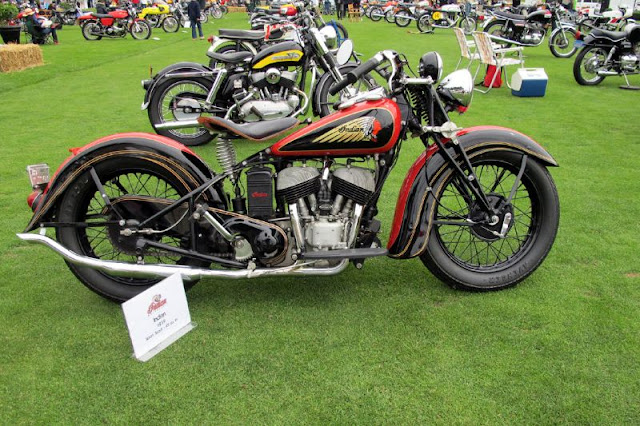Indian Sport Scout
Huge ‘skirted’ fenders became an Indian trademark following their introduction in 1940, but hardly fitted the Sport Scout’s tradition of lively performance. Rear suspension was fitted for the first time in 1941, improving ride comfort but adding weight at the same time. Front suspension was by girder forks, as before.
Early Scouts were successful in a wide variety of official and unofficial competition, and many are still ridden hard today. This is Indian rider Butch Baer in action at Daytona, where Scouts are still successful in vintage events. Racing now takes place at Daytona’s banked Speedway, not the beach where Ed Kretz scored his famous victory in 1937.
Few bikes have made such a vivid impact on the street and in varied forms of competition than the Sport Scout, which was introduced by Indian in 1934. The model’s specification was not particularly exotic. The basics of its 750cc, unit-construction, side-valve V-twin engine and its bolted-together tubular steel frame (called “keystone’ by the factory) had been used by previous Indian machines.
But the Sport Scout combined fine handling with lively acceleration to a top speed of about 80mph (129km/h), and equally importantly it responded well to tuning. Before long, Sports were taking on allcomers on the road, and being stripped for competition in TT races, hillclimbs, endurance events and the increasingly popular production- based Class C dirt-track events.
A string of high-profile successes established the Sport Scout’s reputation. In 1937, Californian hard man Ed Kretz won the inaugural Daytona 200- mile (322km) race on one; and Rollie Free, another legendary Indian star, was timed at 11 lmph (179km/h) on the Daytona beach. The following year, Kretz used his same Sport Scout to win the first TT at Laconia, New Hampshire.
These were troubled times for Indian, with sales low following the Depression. Kretz, in particular, gave the firm a huge boost with his racing exploits. Although he did not win Daytona again, the Californian was America’s most successful racer. That was as much due to his hard riding as to the superiority of his tuned and lightened Sport Scout, which by 1938 produced 35bhp, compared to the standard 22bhp. It was good for about 105mph (169km/h) and weighed just 3201b (145kg), some 1201b (54kg) less than the roadster.
The Sport Scout was the most famous of a long line of Scout models that began with Charles B Franklin’s 615cc model, introduced in 1919. From those earliest days, Indian’s mid-sized V-twin earned a reputation for speed and reliability. In 1920 a Scout covered 1114 miles (1793km) to break the 24-hour world long-distance record by more than 250 miles (402km). In 1927 the engine gained power with a capacity increase to the familiar 750cc.
Built to last
Best of the early models was the 101 Scout, launched in 1928, which combined a long wheelbase and low seating position to give outstanding handling. Its 42-degree side-valve V- twin engine featured unit construction, and was strong enough to justify the Indian advertising line: ‘You can’t wear out an Indian Scout’. Other innovations included a drum front brake, plus new carburettor and oil pump designs.
Not all Scouts were as successful as the 101 and Sport. The Standard Scout, introduced in 1932, was heavier than its 101 predecessor, and was dismissed by many enthusiasts as not sporty enough. The Scout Pony of the same era was a 500cc lightweight, intended as an entry-level machine, but was too slow to be a hit. And its successor the Motoplane, essentially a Pony enlarged to 750cc, was another flop because its power was too much for the unchanged transmission and chassis.
The Sport Scout soon arrived to salvage Indian’s reputation, though, and remained successful long after its production had ended in 1942, winning Class C races as late as 1956. The last production Sport Scouts looked very different to their predecessors because, like all Indian’s range from 1940, they were equipped with the big ‘skirted’ fenders that helped increase weight to 4851b (220kg). The final Sport Scout hardly lived up to its name in standard form, but many owners boosted its performance by enlarging the engine and chopping the fenders.
This 1941 model Sport Scout is a handsome bike, if not a particularly sporty one. Power output was up slightly, to about 25bhp, but the Scout’s skirted fenders and a number of other changes increased weiht to a hefty 4851b (220kg), to the detriment of acceleration.
One variant of the Sport Scout was the Model 741 military machine, whose V-rwin engine was reduced in capacity from 750 to 500cc . The L'S military preferred Harley 45s. but the Model 741 was sold to many Allied forces.
Specification Indian Sport Scout (1934)
- Engine Air-cooled four-valve side-valve 42-degree V-twin
- Capacity 744cc (73 x 89mm)
- Maximum power 22bhp
- Transmission Three-speed, chain final drive
- Frame Sterl twin downtube
- Suspension Girder front; none rear
- Brakes Drum front and rear
- Weight 450lb (204kg)
- Top speed 80mph (129km/h)




















0 comments: